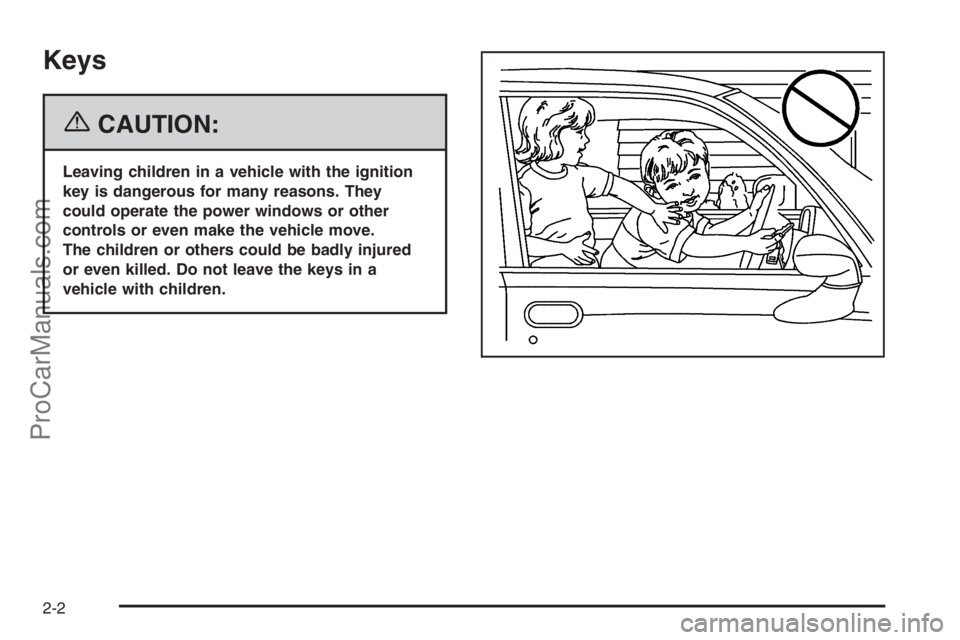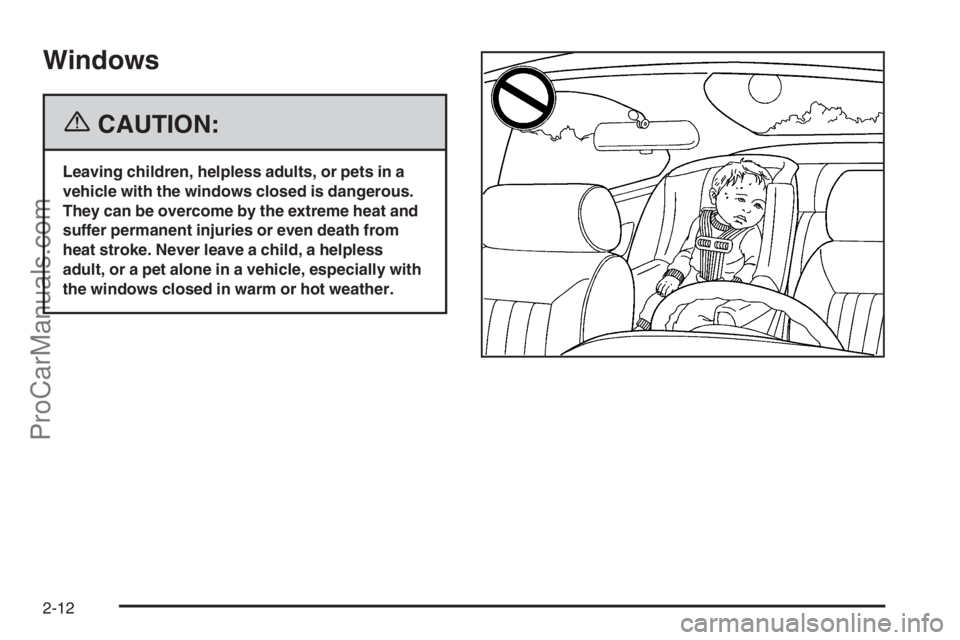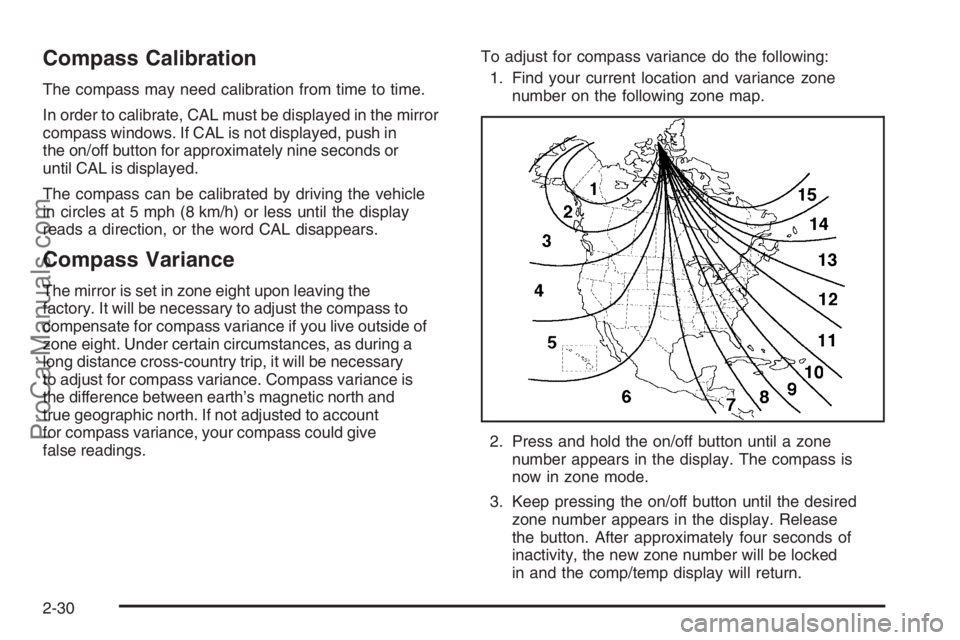window SATURN VUE 2006 User Guide
[x] Cancel search | Manufacturer: SATURN, Model Year: 2006, Model line: VUE, Model: SATURN VUE 2006Pages: 412, PDF Size: 2.89 MB
Page 84 of 412

Keys
{CAUTION:
Leaving children in a vehicle with the ignition
key is dangerous for many reasons. They
could operate the power windows or other
controls or even make the vehicle move.
The children or others could be badly injured
or even killed. Do not leave the keys in a
vehicle with children.
2-2
ProCarManuals.com
Page 93 of 412

Lockout Protection
If you press the power door lock switch when the key
is in the ignition and any door is open, all the doors
will lock and then the driver’s door will unlock. Be
sure to remove the key from the ignition when locking
your vehicle.
If the remote keyless entry transmitter is used to lock
the doors while the key is in the ignition, a chime
will sound three times. All doors will then lock.
Liftgate
{CAUTION:
It can be dangerous to drive with the liftgate
open because carbon monoxide (CO) gas can
come into your vehicle. You cannot see or
smell CO. It can cause unconsciousness and
even death. If you must drive with the liftgate
open or if electrical wiring or other cable
connections must pass through the seal
between the body and the liftgate:
Make sure all other windows are shut.
Turn the fan on your heating or cooling
system to its highest speed and select the
control setting that will force outside air
into your vehicle. SeeClimate Control
System on page 3-19.
If you have air outlets on or under the
instrument panel, open them all the way.
SeeEngine Exhaust on page 2-27.
Use your remote keyless entry transmitter or power
door lock switches to unlock the liftgate.
To open the liftgate, lift the handle located in the
center of the liftgate.
2-11
ProCarManuals.com
Page 94 of 412

Windows
{CAUTION:
Leaving children, helpless adults, or pets in a
vehicle with the windows closed is dangerous.
They can be overcome by the extreme heat and
suffer permanent injuries or even death from
heat stroke. Never leave a child, a helpless
adult, or a pet alone in a vehicle, especially with
the windows closed in warm or hot weather.
2-12
ProCarManuals.com
Page 95 of 412

Power Windows
The window switches
are located on each
side of the shift lever
on the center console.
To lower a window, press the switch down. To raise
a window, pull the switch up.
The power windows operate when the ignition is in
RUN or ACC.
A window switch is also located on each rear door.
Press the bottom of the switch to lower the window.
Press the top of the switch to raise the window.
Express-Down Window
The driver’s window switch has an express-down
feature that is labeled AUTO. This allows the driver’s
window to open fully without having to continuously
press the switch. Press the switch to the second position
and the driver’s window will go all the way down.
To stop the window from lowering, lift the switch all the
way up and release it.
Window Lockout
The driver’s window switches also include a lockout
switch. Press the left side of the switch to prevent rear
passengers from using their window switches. The
driver can still control all the windows with the lockout
on. Press the right side of the window lockout switch
to return to normal window operation.
Sun Visors
To block out glare swing the visors down or to the
side. The driver’s sun visor can be detached from the
center mount and slid along the rod to block different
areas of the front window.
Visor Vanity Mirrors
Your vehicle has covered visor vanity mirrors.
2-13
ProCarManuals.com
Page 109 of 412

Parking Over Things That Burn
{CAUTION:
Things that can burn could touch hot exhaust
parts under your vehicle and ignite. Do not
park over papers, leaves, dry grass, or other
things that can burn.
Engine Exhaust
{CAUTION:
Engine exhaust can kill. It contains the gas
carbon monoxide (CO), which you cannot
see or smell. It can cause unconsciousness
and death.
You might have exhaust coming in if:
Your exhaust system sounds strange
or different.
Your vehicle gets rusty underneath.
Your vehicle was damaged in a collision.
Your vehicle was damaged when driving
over high points on the road or over
road debris.
Repairs were not done correctly.
Your vehicle or exhaust system has been
modi�ed improperly.
If you ever suspect exhaust is coming into
your vehicle:
Drive it only with all the windows down
to blow out any CO; and
Have your vehicle �xed immediately.
2-27
ProCarManuals.com
Page 112 of 412

Compass Calibration
The compass may need calibration from time to time.
In order to calibrate, CAL must be displayed in the mirror
compass windows. If CAL is not displayed, push in
the on/off button for approximately nine seconds or
until CAL is displayed.
The compass can be calibrated by driving the vehicle
in circles at 5 mph (8 km/h) or less until the display
reads a direction, or the word CAL disappears.
Compass Variance
The mirror is set in zone eight upon leaving the
factory. It will be necessary to adjust the compass to
compensate for compass variance if you live outside of
zone eight. Under certain circumstances, as during a
long distance cross-country trip, it will be necessary
to adjust for compass variance. Compass variance is
the difference between earth’s magnetic north and
true geographic north. If not adjusted to account
for compass variance, your compass could give
false readings.To adjust for compass variance do the following:
1. Find your current location and variance zone
number on the following zone map.
2. Press and hold the on/off button until a zone
number appears in the display. The compass is
now in zone mode.
3. Keep pressing the on/off button until the desired
zone number appears in the display. Release
the button. After approximately four seconds of
inactivity, the new zone number will be locked
in and the comp/temp display will return.
2-30
ProCarManuals.com
Page 121 of 412

Instrument Panel Overview...............................3-4
Hazard Warning Flashers................................3-6
Horn .............................................................3-6
Tilt Wheel.....................................................3-6
Turn Signal/Multifunction Lever.........................3-7
Turn and Lane-Change Signals........................3-7
Headlamp High/Low-Beam Changer..................3-8
Flash-to-Pass.................................................3-8
Windshield Wipers..........................................3-8
Windshield Washer.........................................3-9
Rear Window Wiper/Washer...........................3-10
Cruise Control..............................................3-10
Headlamps..................................................3-13
Daytime Running Lamps (DRL).......................3-14
Automatic Headlamp System..........................3-15
Fog Lamps ..................................................3-15
Interior Lamps..............................................3-16
Instrument Panel Brightness...........................3-16
Dome Lamp .................................................3-16
Entry Lighting...............................................3-16
Map Lamps .................................................3-17
Footwell Lamps............................................3-17
Battery Run-Down Protection..........................3-17
Accessory Power Outlet(s).............................3-17
Cigarette Lighter...........................................3-18Climate Controls............................................3-19
Climate Control System.................................3-19
Outlet Adjustment.........................................3-22
Passenger Compartment Air Filter...................3-22
Warning Lights, Gages, and Indicators............3-24
Instrument Panel Cluster................................3-25
Speedometer and Odometer...........................3-26
Trip Odometer..............................................3-26
Tachometer.................................................3-26
Safety Belt Reminder Light.............................3-27
Passenger Safety Belt Reminder Light.............3-27
Airbag Readiness Light..................................3-28
Passenger Airbag Status Indicator...................3-29
Battery Warning Light....................................3-31
Up-Shift Light...............................................3-32
Brake System Warning Light..........................3-32
Anti-Lock Brake System Warning Light.............3-33
Traction Control System (TCS)
Warning Light...........................................3-34
Low Traction Light........................................3-35
Engine Coolant Temperature
Warning Light...........................................3-35
Engine Coolant Temperature Gage..................3-36
Low Coolant Warning Light............................3-36
Section 3 Instrument Panel
3-1
ProCarManuals.com
Page 125 of 412

The main components of the instrument panel are the following:
A. Air Outlets. SeeClimate Control System
on page 3-19.
B. Turn Signal/Multifunction Lever. SeeTurn
Signal/Multifunction Lever on page 3-7.
C. Cruise Control Buttons. SeeCruise Control
on page 3-10.
D. Horn. SeeHorn on page 3-6.
E. Instrument Panel Cluster. SeeInstrument Panel
Cluster on page 3-25.
F. Audio Steering Wheel Controls. SeeAudio Steering
Wheel Controls on page 3-79.
G. Windshield Wiper Lever. SeeWindshield Wipers
on page 3-8.
H. Instrument Panel Brightness Control. SeeInstrument
Panel Brightness on page 3-16.
I. Hazard Warning Flasher Button. SeeHazard
Warning Flashers on page 3-6.
J. Passenger Air Bag Status Indicator. SeePassenger
Airbag Status Indicator on page 3-29.K. Fog Lamp Button (If Equipped) or Traction Control
System Button (If Equipped). SeeFog Lamps
on page 3-15orTraction Control System (TCS)
on page 4-10.
L. Audio System. SeeAudio System(s) on page 3-44.
M. Hood Release. SeeHood Release on page 5-11.
N. Power Mirror Control. SeeOutside Power Mirrors
on page 2-31.
O. Power Window Switches. SeePower Windows
on page 2-13.
P. Automatic Transaxle Shift Lever. SeeAutomatic
Transaxle Operation on page 2-19.
Q. Heated Seats Buttons or Footwell Lamps
(If Equipped). SeeHeated Seats on page 1-4or
Footwell Lamps on page 3-17.
R. Climate Control. SeeClimate Control System
on page 3-19.
S. Glove Box. SeeGlove Box on page 2-34.
3-5
ProCarManuals.com
Page 130 of 412

Rear Window Wiper/Washer
The band on the wiper lever with the smaller arrow
operates the rear wiper/washer.
9(Off):Turn the band to this position to turn off
the rear wiper.
Z(Rear Wiper):Turn the band with the smaller
arrow to this position to turn on the rear wiper. To set
for a shorter or longer delay between wipes, turn
the other band with the larger arrow pointing to the
numbers (1, 2, or 3). Select 3 for the most frequent
movement; select 1 for the least frequent. The band
with the arrow pointing to the numbers (1, 2, or 3)
will affect both the front and rear wipers if they are
on at the same time.
Y(Wash):Turn and hold the band in this position
to spray washer �uid on the rear window. The rear wiper
will also come on. Release the band when enough
�uid has been sprayed on the window. The rear wiper
will run a few additional times after you release it.
The rear window washer uses the same �uid bottle as
the windshield washer. However, the rear window
washer will run out of �uid before the windshield washer.
If you can wash your windshield but not your rear
window, check the �uid level.
Cruise Control
With cruise control, you can maintain a speed of
about 25 mph (40 km/h) or more without keeping
your foot on the accelerator. This can really help on
long trips. Cruise control does not work at speeds
below 25 mph (40 km/h).
{CAUTION:
Cruise control can be dangerous where you
cannot drive safely at a steady speed. So, do
not use your cruise control on winding roads
or in heavy traffic.
Cruise control can be dangerous on slippery
roads. On such roads, fast changes in tire
traction can cause excessive wheel slip, and
you could lose control. Do not use cruise
control on slippery roads.
3-10
ProCarManuals.com
Page 139 of 412

Climate Controls
Climate Control System
With this system you can control the heating, cooling
and ventilation for your vehicle.
Operation
To change the current mode, use the right knob to
select one of the following:
H(Vent):This mode directs air to the instrument
panel outlets.
)(Bi-Level):This mode directs air to the instrument
panel outlets and to the �oor outlets. Cooler air is directed
to the upper outlets and warmer air to the �oor outlets.
6(Floor):This mode directs most of the air to the
�oor outlets with some air directed to the windshield.
When you select this mode, the system will turn
recirculation mode off and run the air conditioning
compressor unless the outside air is at or below
freezing. Recirculation mode cannot be selected while
in �oor mode. This helps prevent window fogging
and moisture building up within the cabin.
The right knob can also be used to select defog or
defrost mode. See “Defogging and Defrosting” later
in this section.
A(Fan):Turn the left knob clockwise to increase
the fan speed or counterclockwise to decrease the fan
speed. To turn the fan off, turn the left knob all the
way counterclockwise. In any setting other than off,
the fan will run continuously with the ignition on.
The fan must be turned on to run the air conditioning
compressor. There will be some air�ow noticeable from
the various outlets when driving, even with the fan in
the off position. This is to ensure some fresh air is
always available in the vehicle.
Temperature Control:Turn the center knob clockwise
to increase or counterclockwise to decrease the
temperature inside your vehicle.
3-19
ProCarManuals.com